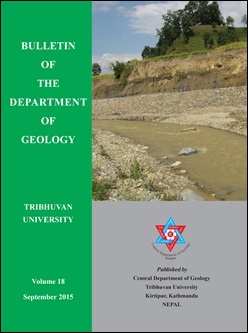Evaluation of strength and durability of rocks from Malekhu-Thopal Khola area, Central Nepal Lesser Himalaya for construction aggregates
DOI:
https://doi.org/10.3126/bdg.v18i0.16454Keywords:
Aggregates, durability, index properties, strength, Los Angeles abrasion, rock mass ratingAbstract
Aggregate, the inert materials used in almost every field of modern development structures have great influence. Aggregates may look similar in appearance but they may carry different physical, mechanical and chemical properties and they may perform accordingly. End uses of aggregates are also determined by their performance. The Lesser Himalaya of the Malekhu- Thopal area comprises more than 14 formations having great potential of rock aggregates. The present study was carried out in order to reveal the toughness and soundness of each rock type of the Lesser Himalaya so that durability can be determined. Altogether 25 representative samples were tested to find porosity, specific gravity, dry density, uniaxial compressive strength (UCS), Los Angeles abrasion value (LAAV), aggregates impact value (AIV), sodium sulphate soundness Value (SSSV), ethylene glycol soaking value and water absorption value (WAV). Results were compared with standards of different specifications and recommended for wide range end uses.
Rock mass rating of each formation was carried out and the value ranges from 36 to 82. Specific gravity ranges from 2.08 to 3.08 and the dry density ranges from 2.3 to 3.22 g/cm3. All the samples have porosity less than 2% except the samples of the Benighat Slate. UCS value ranges from 5.9 to 301.9 MPa. The LAAV of the sample lies between 19.6% and 47.5%. AIV is between 8.54% and 34.28%. The SSSV ranges from 2.35 to 26.06%. Ethylene glycol soak index is 2 of all samples signifying that proportion of swelling clays or low accessibility of ethylene glycol through the samples due to low porosity. WAV of all the samples is below 2% except the Benighat Slates which indicates that the aggregates have low effective porosity. The entire test shows that most of the sample meets different national and international standards and can be recommended for wide range of end uses.
Bulletin of the Department of Geology, Vol. 18, 2015, pp. 15–34
Downloads
Downloads
Published
How to Cite
Issue
Section
License
© Central Department of Geology, Tribhuvan University, Nepal

